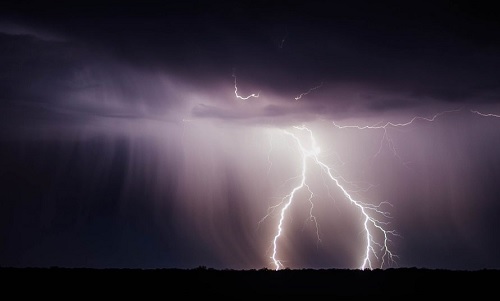Washington/New Delhi (ISJ): India recorded 34 percent rise in lightning strikes in 2020-21, according to the Annual Lightning Report. The Report by Climate Resilient Observing Systems Promotion Council (CROPC) – a multi-agency initiative including India Meteorological Department, recorded that lightning killed 1,619 people between April 2020 and March 2021.
The report revealed, the highest rise in lightning took place in Punjab, with a rise of 331 percent, while states like Bihar, Haryana, Puducherry, Himachal Pradesh and West Bengal too had recorded higher incidents of lightning.
In the United States, lightning sparked the massive California Lightning Complex fires in 2020.
A new study led by the University of Washington shows that machine learning — computer algorithms that improve themselves without direct programming by humans — can be used to improve lightning forecasts.
Better lightning forecasts could help to prepare for potential wildfires, improve safety warnings for lightning and create more accurate long-range climate models.
“The best subjects for machine learning are things that we don’t fully understand. And what is something in the atmospheric sciences field that remains poorly understood? Lightning,” said Daehyun Kim, an associate professor of atmospheric sciences at the University of Washington. “To our knowledge, our work is the first to demonstrate that machine learning algorithms can work for lightning.”
The new technique combines weather forecasts with a machine learning equation based on analyses of past lightning events. The hybrid method, presented Dec. 13 at the American Geophysical Union’s fall meeting, can forecast lightning over the south-eastern U.S. two days earlier than the leading existing technique.
“This demonstrates that forecasts of severe weather systems, such as thunderstorms, can be improved by using methods based on machine learning,” said Wei-Yi Cheng, who did the work for his doctorate in atmospheric sciences at the University of Washington. “It encourages the exploration of machine learning methods for other types of severe weather forecasts, such as tornadoes or hailstorms.”
Researchers trained the system with lightning data from 2010 to 2016, letting the computer discover relationships between weather variables and lightning bolts. Then they tested the technique on weather from 2017 to 2019, comparing the AI-supported technique and an existing physics-based method, using actual lightning observations to evaluate both.
The new method was able to forecast lightning with the same skill about two days earlier than the leading technique in places, like the south-eastern U.S., that get a lot of lightning. Because the method was trained on the entire U.S., its performance wasn’t as accurate for places where lightning is less common.
The approach used for comparison was a recently developed technique to forecast lightning based on the amount of precipitation and the ascent speed of storm clouds. That method has projected more lightning with climate change and a continued increase in lightning over the Arctic.
“The existing method just multiplies two variables. That comes from a human’s idea, it’s simple. But it’s not necessarily the best way to use these two variables to predict lightning,” Kim said.
The machine learning was trained on lightning observations from the World Wide Lightning Location Network, a collaborative based at the University that has tracked global lightning since 2008.
The researchers hope to improve their method using more data sources, more weather variables and more sophisticated techniques. They would like to improve predictions of particular situations like dry lightning, or lightning without rainfall, since these are especially dangerous for wildfires.
Source: University of Washington / Climate Resilient Observing Systems Promotion Council
Image Courtesy: University of Washington


